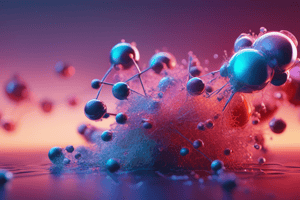Podcast
Questions and Answers
Какое основное влияние оказывают свободные радикалы и активные формы кислорода на клетку?
Какое основное влияние оказывают свободные радикалы и активные формы кислорода на клетку?
- Не оказывают никакого значимого влияния на клетку
- Стимулируют деление клеток и их рост
- Улучшают функциональные свойства клеточной мембраны
- Нарушают структуру и функции клеточных органелл, вызывая дисфункцию и гибель клетки (correct)
Какие типы модификаций белков могут вызывать свободные радикалы и активные формы кислорода?
Какие типы модификаций белков могут вызывать свободные радикалы и активные формы кислорода?
- Гидроксилирование, сульфенилирование, глутатионилирование
- Окислительная декарбоксилирование, ацилирование, дезаминирование
- Дитирозиновое сшивание, карбонилирование, нитрование (correct)
- Фосфорилирование, ацетилирование, метилирование
Каким образом окислительное повреждение ДНК может влиять на функционирование клетки?
Каким образом окислительное повреждение ДНК может влиять на функционирование клетки?
- Улучшает точность транскрипции и трансляции генетической информации
- Не оказывает никакого влияния на функционирование клетки
- Стимулирует ускоренное деление клеток
- Приводит к мутациям, делециям, вставкам и хромосомным нарушениям, вызывая ошибки в экспрессии генов и потенциальную гибель клетки или опухолевую трансформацию (correct)
Какие заболевания могут быть связаны с чрезмерным накоплением свободных радикалов и активных форм кислорода в организме?
Какие заболевания могут быть связаны с чрезмерным накоплением свободных радикалов и активных форм кислорода в организме?
Какие биологические молекулы наиболее уязвимы к окислительному повреждению со стороны свободных радикалов и активных форм кислорода?
Какие биологические молекулы наиболее уязвимы к окислительному повреждению со стороны свободных радикалов и активных форм кислорода?
Что такое свободные радикалы?
Что такое свободные радикалы?
Какие реакции в организме приводят к образованию реактивных форм кислорода (ROS)?
Какие реакции в организме приводят к образованию реактивных форм кислорода (ROS)?
Какой процесс нарушает целостность мембраны клетки, увеличивает ее проницаемость и ухудшает ее текучесть?
Какой процесс нарушает целостность мембраны клетки, увеличивает ее проницаемость и ухудшает ее текучесть?
Какие молекулы являются частью реактивных форм кислорода?
Какие молекулы являются частью реактивных форм кислорода?
Что является основной причиной отрицательного влияния свободных радикалов на клетки?
Что является основной причиной отрицательного влияния свободных радикалов на клетки?
Flashcards are hidden until you start studying
Study Notes
Free Radical Oxidation: Understanding Cell Damage
Free radicals are highly reactive molecules with unpaired electrons, which can cause damage to cells and tissues within the body. They play a crucial role in various physiological processes such as programmed cell death, tissue repair, and immune defense against pathogens. However, when their levels become imbalanced, they can lead to oxidative stress, contributing to cellular dysfunction and disease.
What Are Reactive Oxygen Species?
Reactive oxygen species (ROS) are free radicals derived from oxygen. These include superoxide anions (O2−), hydrogen peroxide (H2O2), hydroxyl radicals (•OH), singlet oxygen (*O2), and others. ROS are produced during normal metabolism, such as during cell respiration, where they function as signaling molecules for stress responses within cells. However, excessive production of ROS can lead to oxidative damage due to their reactivity with lipids, proteins, and nucleic acids.
Cell Damage from Free Radicals and Reactive Oxygen Species
Free radicals and reactive oxygen species cause cellular damage primarily through three mechanisms:
Lipid Peroxidation
Lipid peroxidation occurs when ROS attacks polyunsaturated fatty acids in cell membranes, leading to the formation of lipid peroxides. This process disrupts the integrity of the membrane, impairs its fluidity, and increases membrane permeability. These changes alter the structural and functional properties of the cell membrane and can also affect other organelles, leading to cell dysfunction and death.
Protein Oxidation
Protein oxidation involves modification of amino acid residues in proteins, which can alter their structure, function, and interactions with other proteins or lipids. Some examples of protein modifications include dityrosine crosslinking, carbonylation, nitration, sulfenylation, and glutathionylation. Changes in protein structure can result in impaired enzyme activity, altered protein-protein interactions, and aberrant activation of signaling pathways, ultimately affecting cell physiology and survival.
DNA Damage
DNA contains electron-rich bases that make it vulnerable to oxidative attack by free radicals. When these atoms lose electrons, they create a cyclic compound called an adduct, which can distort DNA structure and prevent proper transcription or translation of genetic information. This can lead to mutations, deletions, insertions, or chromosomal fragmentation, causing errors in gene expression and potentially resulting in cell death or tumors.
In summary, free radical oxidation involves the generation of highly reactive molecules known as free radicals and reactive oxygen species (ROS). Excessive levels of these compounds can cause cellular damage through processes such as lipid peroxidation, protein oxidation, and DNA damage, leading to various health issues, including cancer, cardiovascular disease, neurodegenerative disorders, and aging.
Studying That Suits You
Use AI to generate personalized quizzes and flashcards to suit your learning preferences.





